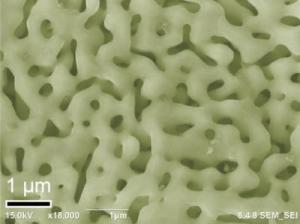May 5 2014
Three-dimentional (3D) nanoporous graphene with preserved 2D Dirac electronic characters was successfully synthesized by Dr. Yoshikazu Ito and Prof. Mingwei CHEN at Advanced Institute for Materials Research (AIMR), Tohoku University.
 This is nanoporous graphene on a nanoporous Ni template by chemical vapor deposition method. Credit: Yoshikazu Ito
This is nanoporous graphene on a nanoporous Ni template by chemical vapor deposition method. Credit: Yoshikazu Ito
The nanoporous graphene is constructed by a single layer graphene sheet that is continuously inter-connected to form a complex 3D network structure. This free-standing nanoporous graphene with an excellent crystallinity possesses high mobility, holding great promise for the applications in electronic devices.
The nanoporous graphene were grown by a nanoporous metal based chemical vapor deposition (CVD) method as shown in Figure 1(a). The overall morphology of the nanoporous graphene in Figure 1(b) shows a ~20 µm thick free-standing bulk sheet. Although the 3D nanoporous graphene has a complex structure, it is demonstrated to be 500 cm2/Vs in electron mobility and a mass-less Dirac cone system. As the conventional transistor requires electron mobility of 200 cm2/Vs, it is greatly expected that this nanoporous graphene will bring a new device which can be replaced with Si devices.
This work is collaborated with the research teams of Prof. Katsumi Tanigaki and Prof. Takashi Takahashi at AIMR, Tohoku University. This research results will be published in issue 19 of 'Angewandte Chemie International Edition' as a Hot Paper on 2 May.
Source: http://www.wpi-aimr.tohoku.ac.jp/